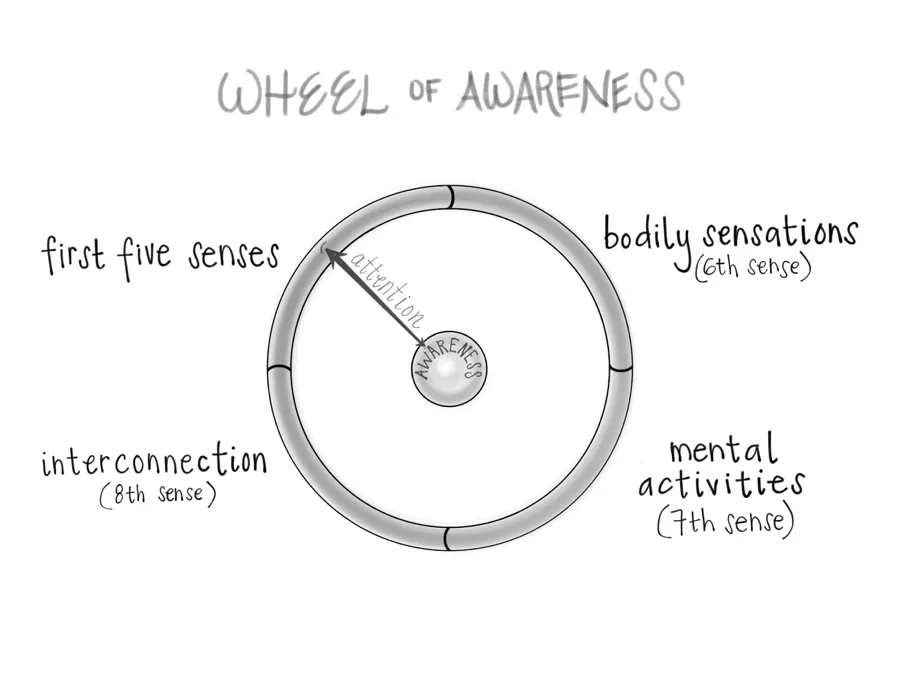
My attention has been everywhere these days, in ways that are creating profound blissful sensations, and ways that are creating fear and fragmentation. So I decided to write about it, in a really deep and complex way.
Attention is a relational process. If something has our attention, it also has us. What we pay attention to shapes our thoughts, actions, and behaviors. At the heart of any mindfulness and emotional regulation training is noticing where your mind is at, tuning into the sensations and emotions arising in the body, and learning how to redirect your experience with what you choose to focus on.
Our attention can also be a beautiful expression of how we show love to others. As Thich Nhat Hanh once said, "the most precious gift we can offer anyone is our attention. When mindfulness embraces those we love, they will bloom like flowers."
Attention is so powerful, however, that it's the most sought-after commodity. Now more than ever before. Everything’s getting bigger, brighter, more convenient and more sensational, effectively keeping many of us distracted. Countless apps, websites, advertisements, and interactive user interfaces are designed to profit off of capturing our attention. Someone on KPFA, a local independent radio show, was talking about how capitalism isn't even an economic system anymore, as much as a lifestyle. As the CEO of Netflix once said, the corporation's biggest competition is sleep.
While this paints a gloomy picture of being victims to our environment, it might also inspire us to slow things down and start asking deeper questions about what we really want to create in our lives. And where does our energy and attention serve best to help make space for it?
When I taught mindfulness and emotional regulation skills in schools to youth and adults, one of my favorite metaphors I would use is that our minds are like excited puppy dogs running around, sniffing everything that's interesting and constantly assessing threats. This is the nature of the mind. Yet mindfulness invites the process of learning how to be self-directed, and not solely directed by external environmental factors. So what would it be like to notice what the puppy in your mind is sniffing, and call the puppy back? At this point, people usually smile upon hearing this, as they imagine the soft furry thing running back with its tongue sticking out, loyal and watchful towards their owner. Back into the present moment or reality.
The remedy to the constant command for our attention lies in ourselves. We decide who gets it, how it consciously impacts us, and whether it makes us better. With awareness of attention, we find the pause that creates a space between impulse and action. We can find other choices in how to respond in the moment. As a result, we might start noticing what's possible with all the energy that becomes available to us, when we don't throw it away into distraction, busyness, or disempowering thinking.
"The world as we have created it is a process of our thinking. It cannot be changed without changing our thinking.” - Albert Einstein
And so we might ask, how do we go about changing our thinking? By changing what we give our attention to, in service to our intentions. Intention describes the placement, power and quality of the attention.
If we're solely focused on what's going wrong and what's not working, we might find that we create more problems and suffering for ourselves. If we are living our lives passively without any clear focus of what we don't like or what we want, we find ourselves stagnant and possibly depressed. If we are naming and clarifying what we want and need, we are more likely to identify constructive solutions and attract people and places that help create a container for change and transformation.
I once heard from a friend that if we find ourselves waiting for something to happen, it means that we haven't built the right container for what we are manifesting into our lives... yet. According to my friend, the waiting time equals the time it takes for us to clarify and move towards what we desire, which builds the container. And that we need to stretch outside of our comfort zones, to the spaces where we do feel deserving of what we want, to make space for what we are calling in. Getting grounded with what this specifically looks like becomes the focus of our attention, which can catalyze positive change.
Dr. Dan Siegel, known for his pioneering work in science-based meditation practice, speaks on the implications of this:
In the field of interpersonal neurobiology, we view the mind as an emergent property of energy and information flow. When we train the mental process of attention, for example, we learn to strengthen how to direct the flow of energy and information. Much like a light focusing on a particular aspect of our experience, this ability illuminates and stabilizes what is being perceived so that we sense with more focus, depth, and detail.
Building upon the nature of the mind, Siegel created what he calls the “Wheel of Awareness," a form of focusing attention in an integrative, mindful way.

In this metaphor for the mind, the hub represents awareness, and the points on the rim of the wheel represent that which we can be aware of. Sights and sounds to our sense of the body, our thoughts and feelings, and our sense of connections to others. These are the elements of consciousness that can be differentiated from one another, and then linked. Dr. Rick Hanson states in his book Buddha's Brain: The Practical Neuroscience of Happiness, Love, and Wisdom, that "an awakening mind means an awakening brain. For instance, when experienced Tibetan practitioners go deep into meditation, they produce uncommonly powerful and pervasive gamma brainwaves of electrical activity, in which unusually large regions of neural real estate pulse in synchrony 30-80 times a second, integrating and unifying large territories of the mind."
As a regulating process, the mind can have two functions—monitoring and modifying—both of which can be strengthened. Mind training essentially teaches us how to stabilize monitoring and then learn to modify energy and information flow toward something we can simply call integration. Integration is the linking of differentiated element of a system, like the two sides of the brain, or two people in a relationship. A long line of scientific reasoning suggests that integration is the basis of well-being and health.
Siegel suggests that integration deepens when our mindful attention can illuminate the nature of presence, an internal process of becoming open and receptive to whatever arises in our lives. This is true for our relationships as well:
Presence in relationships means being open to connecting with the differentiated nature of others, creating compassionate and respectful communication while linking yet maintaining a differentiated sense of an inner self. In this important way, integration is more like a fruit salad than a smoothie—we maintain our differentiated nature and link, yet we do not become homogenized.
For me, the states of focused attention from yoga, meditation, and movement practices are very helpful in being more present throughout the day. What I'm learning about directing my attention inwards, through movement or mindfulness for example, is that being in touch with my inner realities doesn't mean I need to have everything figured out or that everything needs to be perfect. It doesn't matter if the session was good or bad, right or wrong, or a success or failure. It's not a performance. It's just the simple act of practicing the muscle of redirecting my attention to something that that is constructive and integrative. And that sometimes the solution to our challenges, even the complicated ones, lies in the simple practice of accepting what is. At times I'll follow the music beat and let it take me through dance, sometimes I don't listen to anything, sometimes I lay down and close my eyes, sometimes I go out in nature and breathe fresh air. The point of being present is that you’re in relationship with whatever is arising in the current context, wherever you’re standing from that location that day. Nothing is fixed.
Here's an interesting quote by Joe Dispenza about how our quality and fixation of attention can help create new ways of being in life that don't rely on stagnant habits and patterns:
If where you place your attention is where you place your energy, the moment you place your attention on a familiar emotion, your attention & your energy is in the past. If those familiar emotions are connected to a memory of some past event involving a person or an object at a particular place and time, your attention and your energy are in the past as well. As a consequence, you are siphoning your energy out of the present moment and into your past. If you start to think about all the people you have to see, things you have to do, & the places you have to go at certain times in your routine day, you are siphoning your attention and energy into a predictable known future. All your energy is now completely commingled with those known experiences in that specific line of time. Your energy is creating more of the same and your body is going to follow your mind to the same events in your same reality. Your energy is being directed out of the present moment and into the past and the future. As a result, you have very little energy left to create an unknown experience in a new timeline.
Most people have been on the same routine for years on end, they get up at the same time, drive to work at the same time, etc. And if you’ve done that for the last 15 years, your body is going to effortlessly coast into that routine. Your body is following the mind - but in this case, it’s been repeatedly following your mind to the known. That’s because that’s where your attention - and, therefore, your energy is.
Could it ever be possible for your body to start following your mind to the unknown? If so, you can see that you would have to change where you put your attention, that would lead to changing your energy, which would require you to change how you think and how you feel long enough for something new to happen. It makes sense that just as your body has been following your mind to every known experience in your life, if you were to start investing your attention and energy into the unknown, your body would then be able to follow your mind into the unknown - a new experience in your future.
Are you stepping into the unknown today?
So what are you putting your attention on?
I'll end this long post with a funky video of me, practicing today's version of focused attention with some balance-testing yoga moves and shuffling without shoes lol. And yes, I like to practice yoga without a mat, much to the complaints and criticisms from yogi friends ;)
Tracks:
- Heavy (Icarus Extended Remix) - Bow Anderson, Icarus
- fall back - Moby, Akemi Fox, always centered at night
- Drifter (Chill Mix) - Morgin Madison, Dominique